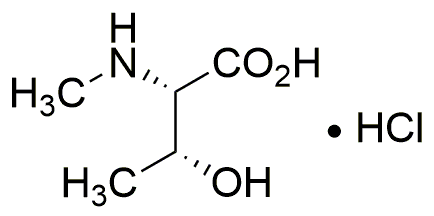N-Methyl-L-threonine hydrochloride is widely utilized in research focused on:
- Amino Acid Supplementation: This compound serves as a dietary supplement in sports nutrition, promoting muscle recovery and enhancing performance for athletes.
- Pharmaceutical Development: It is used in the synthesis of various pharmaceuticals, particularly in the development of drugs targeting neurological disorders due to its role in neurotransmitter synthesis.
- Biochemical Research: Researchers utilize it to study metabolic pathways and protein synthesis, providing insights into cellular functions and disease mechanisms.
- Animal Feed Additives: The compound is incorporated into animal feed to improve growth rates and overall health in livestock, contributing to more efficient food production.
- Cosmetic Formulations: It finds application in cosmetic products for its moisturizing properties, enhancing skin hydration and texture in skincare formulations.
General Information
Properties
Safety and Regulations
Applications
N-Methyl-L-threonine hydrochloride is widely utilized in research focused on:
- Amino Acid Supplementation: This compound serves as a dietary supplement in sports nutrition, promoting muscle recovery and enhancing performance for athletes.
- Pharmaceutical Development: It is used in the synthesis of various pharmaceuticals, particularly in the development of drugs targeting neurological disorders due to its role in neurotransmitter synthesis.
- Biochemical Research: Researchers utilize it to study metabolic pathways and protein synthesis, providing insights into cellular functions and disease mechanisms.
- Animal Feed Additives: The compound is incorporated into animal feed to improve growth rates and overall health in livestock, contributing to more efficient food production.
- Cosmetic Formulations: It finds application in cosmetic products for its moisturizing properties, enhancing skin hydration and texture in skincare formulations.
Documents
Safety Data Sheets (SDS)
The SDS provides comprehensive safety information on handling, storage, and disposal of the product.
Product Specification (PS)
The PS provides a comprehensive breakdown of the product’s properties, including chemical composition, physical state, purity, and storage requirements. It also details acceptable quality ranges and the product's intended applications.
Certificates of Analysis (COA)
Search for Certificates of Analysis (COA) by entering the products Lot Number. Lot and Batch Numbers can be found on a product’s label following the words ‘Lot’ or ‘Batch’.
*Catalog Number
*Lot Number
Certificates Of Origin (COO)
This COO confirms the country where the product was manufactured, and also details the materials and components used in it and whether it is derived from natural, synthetic, or other specific sources. This certificate may be required for customs, trade, and regulatory compliance.
*Catalog Number
*Lot Number
Safety Data Sheets (SDS)
The SDS provides comprehensive safety information on handling, storage, and disposal of the product.
DownloadProduct Specification (PS)
The PS provides a comprehensive breakdown of the product’s properties, including chemical composition, physical state, purity, and storage requirements. It also details acceptable quality ranges and the product's intended applications.
DownloadCertificates of Analysis (COA)
Search for Certificates of Analysis (COA) by entering the products Lot Number. Lot and Batch Numbers can be found on a product’s label following the words ‘Lot’ or ‘Batch’.
*Catalog Number
*Lot Number
Certificates Of Origin (COO)
This COO confirms the country where the product was manufactured, and also details the materials and components used in it and whether it is derived from natural, synthetic, or other specific sources. This certificate may be required for customs, trade, and regulatory compliance.


